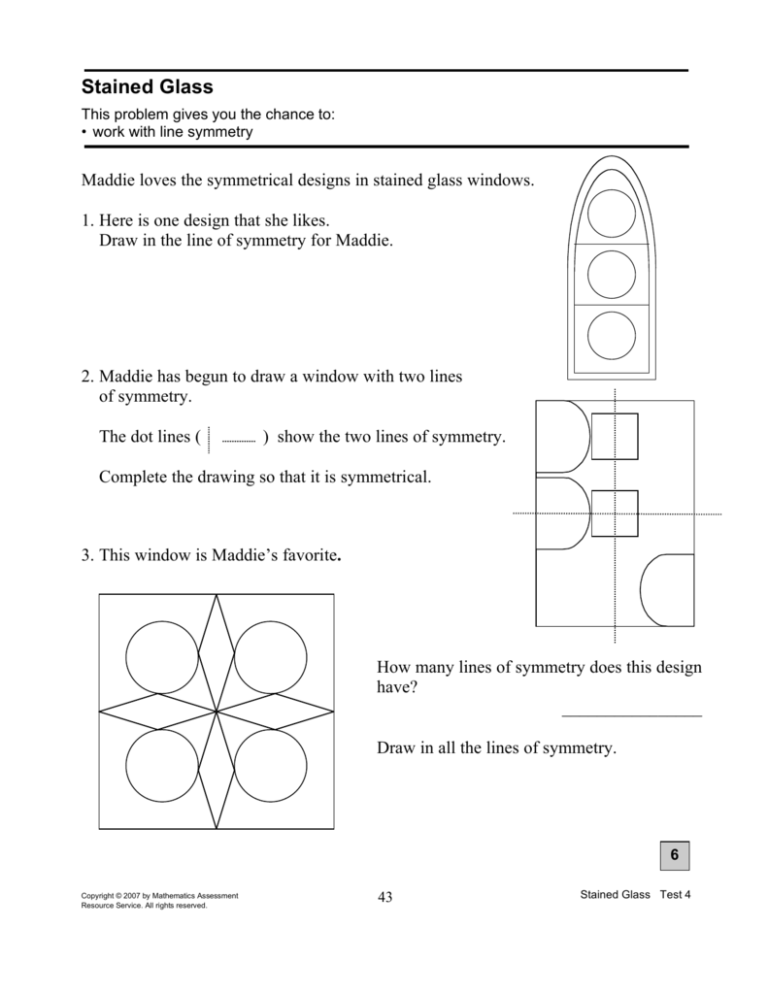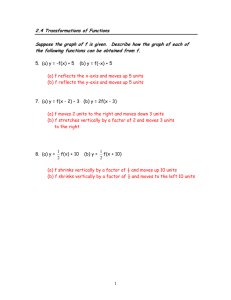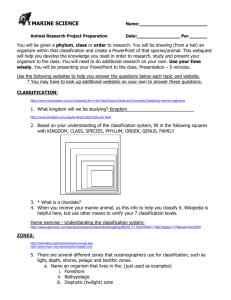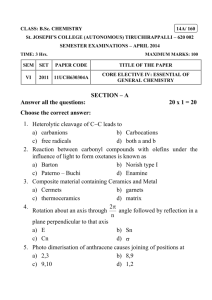
Stained Glass
This problem gives you the chance to:
• work with line symmetry
Maddie loves the symmetrical designs in stained glass windows.
1. Here is one design that she likes.
Draw in the line of symmetry for Maddie.
2. Maddie has begun to draw a window with two lines
of symmetry.
The dot lines (
) show the two lines of symmetry.
Complete the drawing so that it is symmetrical.
3. This window is Maddie’s favorite.
How many lines of symmetry does this design
have?
________________
Draw in all the lines of symmetry.
6
Copyright © 2007 by Mathematics Assessment
Resource Service. All rights reserved.
43
Stained Glass Test 4
Task 3: Stained Glass
Rubric
The core elements of performance required by this task are:
• work with line symmetry
points
section
points
Based on these, credit for specific aspects of performance should be assigned as follows
1.
Draws a correct line of symmetry with no extras.
1
2.
Completes the design correctly.
2
Partial credit
One or two errors
3
(1)
Gives correct answer: 4
1
Draws all 4 lines of symmetry with no extras
2
Partial credit
Draws two correct lines of symmetry with no extras.
(1)
Total Points
Copyright © 2007 by Mathematics Assessment
Resource Service. All rights reserved.
44
1
2
3
6
Stained Glass Test 4
Stained Glass
Work the task. Look at the rubric. What are the big mathematical ideas being assessed
in this task?
Look at student work for part 1. How many of you students drew:
Vertical line of symmetry Vertical and horizontal line
Horizontal line
Do you think students get too many examples of just one type of symmetry? Look
through the examples in your text.
In part 2, many students had difficulty adding the missing parts to the drawing to make
a design with horizontal and vertical symmetry. How is the thinking for doing this part
of the task cognitively different from filling in lines of symmetry? What are all the
things you need to consider to do this part successfully?
Look at student work. How many of your students could draw in:
All the border
All the border
Just the square
Only added
Only fill in
parts and the
pieces
new lines but
some of the
square
no objects
border bits
What opportunities have your students had with trying to use the logic of symmetry to
fill in missing parts?
Look at student work for part 3. How many of your students thought there were:
4 lines of
16 lines of
No lines of
2 lines of
Outlined the
Other
symmetry
symmetry
symmetry
symmetry
star
Did your students draw their lines on the diagram or mark them off to the side?
Do you think students who made their lines longer than the edge of the design had an
easier job counting the lines of symmetry? Did some students count the same line
twice?
What understandings do you want students at this grade level to have about symmetry?
Copyright © 2007 by Noyce Foundation
Resource Service. All rights reserved.
45
Looking at Student Work on Stained Glass
Student A is able to complete all the elements of the task including filling in the
complete border and third square in part 2. Student A draws the lines of symmetry
beyond the edges of the design. Do you think this might make it easier for students to
think about line as a continuous object rather than counting the places where it
intersects the border?
Student A
Copyright © 2007 by Noyce Foundation
Resource Service. All rights reserved.
46
Filling in the missing elements to make part 2 a symmetrical design was challenging for
students. They had to think about what would happen if the shape was folded.
Students might think about moving the left side to the right and forget that the bottom
right also needed to be mirrored on the left side. Then they needed to consider the
horizontal line of symmetry. Students B and C illustrate some of the most common
mistakes.
Student B
Student C
Student D doesn’t fill in any elements in part 2, but just darkens the lines of symmetry.
In part 3 the student doesn’t consider the possibility of a diagonal line of symmetry.
Does your text give enough examples of symmetry that is not vertical or horizontal?
Student D
Copyright © 2007 by Noyce Foundation
Resource Service. All rights reserved.
47
Students seem to have a tendency to draw in vertical and horizontal lines of symmetry
without thinking. Several students, like Student E, drew in the horizontal line and then
needed to change their mind. Student E has only made the horizontal and vertical lines
of symmetry in part 3 but has counted 8 lines. It is unclear what the student is
considering.
Student E
Copyright © 2007 by Noyce Foundation
Resource Service. All rights reserved.
48
Student F seems to have no idea about symmetry. In part one the student makes a new
design. In part two the student just darkens the information about lines. In part three
the student is counting or miscounting the line segments with the drawing.
Student F
Copyright © 2007 by Noyce Foundation
Resource Service. All rights reserved.
49
Some students did not put their lines on the design in part 3. Is this about trying to do
symmetry out of book where you can’t draw on the picture? Enough students, from
different districts, did this to make the issue worth considering. If you could interview
the child what questions would you ask?
Student G
Copyright © 2007 by Noyce Foundation
Resource Service. All rights reserved.
50
4th Grade
Student Task
Core Idea 4
Geometry
and
Measurement
Task 3
Stained Glass
Work with line symmetry and complete patterns when the lines of
symmetry are drawn.
Use characteristics, properties, and relationships of twodimensional geometric shapes.
• Understand line symmetry.
Based on teacher observation, this is what fourth graders knew and were able to do:
• Recognize vertical and horizontal lines of symmetry.
Areas of difficulty for fourth graders:
• Making a design symmetrical, using logic to complete the design
• Counting lines of symmetry, not doubling counting a line
• Diagonal lines of symmetry
Copyright © 2007 by Noyce Foundation
Resource Service. All rights reserved.
51
The maximum score available on this task is 6 points.
The minimum score needed for a level 3 response, meeting standards, is 3 points.
Most students, 92%, could draw in the vertical line of symmetry in part one. Many students,
73%, could draw in the vertical line of symmetry and complete some of the elements in part 3
involving drawing and counting lines of symmetry. More than half the students, 62%, could
draw and count lines of symmetry including diagonals. 25% could meet all the elements of
performance including working backwards from the lines of symmetry to completing all the
elements of the design. 8% of the students scored no points on this task. 83% of the students
with this score attempted the task.
Copyright © 2007 by Noyce Foundation
Resource Service. All rights reserved.
52
Stained Glass
Points
0
Understandings
83% of the students with this
score attempted the task.
1
Students could draw in the
vertical line of symmetry in part
1.
3
Students could draw in the line
of symmetry in part 1 and do
some of the demands in part 3.
4
6
Misunderstandings
11% of the students put a vertical and a
horizontal line of symmetry in part 1. 5%
of the students put just a horizontal line
of symmetry. 5% did not attempt this part
of the task.
10.5% of the students thought there were
only 2 lines of symmetry in part 3. 9%
thought there were 8 lines of symmetry in
part 3. 6% thought their were 16 lines of
symmetry.
13% drew in only the vertical and
horizontal line of symmetry in part 3. 5%
outlined the star instead of making lines
of symmetry. 4% made some parallel
vertical or horizontal lines of
symmetry.6% added in other types of
extra lines.
Students couldn’t complete any of the
elements in part 2. 23% did not attempt
part 2. 14% just darkened the existing
lines of symmetry. 11% added more lines
to part 2, but put in none of the objects
needed to complete the design.
Students could accurately draw
in lines of symmetry, including
diagonal lines of symmetry.
Students could work backwards
from lines of symmetry to
filling in a design that would
have those symmetrical lines.
Copyright © 2007 by Noyce Foundation
Resource Service. All rights reserved.
53
Implications for Instruction
Students need to have practice working with geometrical relationships, such as line symmetry.
They should have opportunities to draw in lines of symmetry and use mirrors to check for lines
of symmetry. They should be able to work with a variety of shapes and designs, where the lines
of symmetry are not always or limited to the horizontal and vertical.
Students thinking about symmetry should include developing the logic of mentally
unfolding a shape and recording the design. Drawing the mirror image can be very
challenging for students. Understanding the movement of object across the line of
symmetry is the important mathematics of this piece. This lays the ground work for
later thinking around transformational geometry including dilations, reflections,
translations, and rotations.
Ideas for Action Research – Developing Self-Talk
Some students have a natural ability to ask themselves questions that help them think
through solving a problem. Other students benefit from explicit instruction about the
process. Find some interesting symmetry tasks, but only provide a portion of the
design.
from Teaching Student Centered Mathematics by Jon Van de Walle
Then model some self- talk for your example: “I know that a line of symmetry means
that if it were folded along the line both sides would be the same. So if I unfolded the
shape here, . . . . . . .” and have students come up and try to explain their though
Copyright © 2007 by Noyce Foundation
Resource Service. All rights reserved.
54
processes. This is interesting to watch as you see a classroom of heads moving and
hands turning as they think through the movements of the shapes.
Fold four paper squares in fourths. Make a V-cut in each square as shown by the
drawing below. The thick edges in each drawing represents the folded edges of each
square.
Before unfolding each square, tell what you think the design might look like and make
a drawing of your prediction.
After opening the square, analyze them next to your drawing. Are they alike? Are they
different? How?
Can you find more examples of symmetry tasks to help your students practice self-talk,
while exporing ideas of symmetry and reflection.
Copyright © 2007 by Noyce Foundation
Resource Service. All rights reserved.
55
The last two tasks are from Interactive Mathematics: Through the Looking Glass by
David Foster.
Copyright © 2007 by Noyce Foundation
Resource Service. All rights reserved.
56










